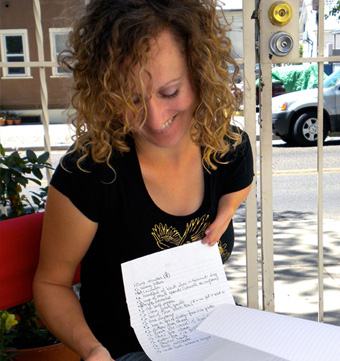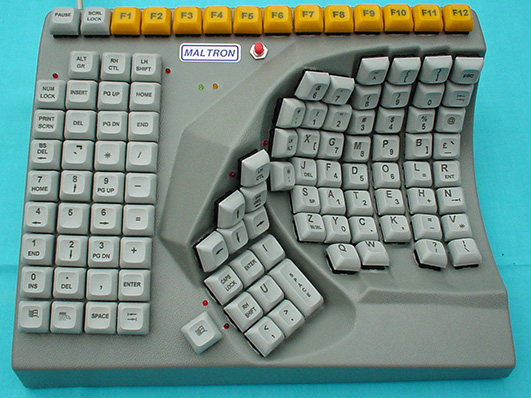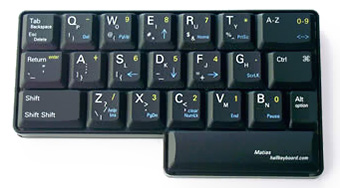Without a second thought, most people can sit down at a computer keyboard and begin to type. For a person with only one arm or hand, however, computers present an obstacle that is not easily overcome. Those lacking the use of an arm or hand can adapt to using a standard keyboard, but options that might better serve them are severely limited by availability, price, and portability. It’s a void that user experience designers are in a unique position to fill.
With bass drum banging, snare tapping, and cymbals splashing, Alex Wegman1 has expressive stage presence and natural talent. He can do drum rolls and fills, and he loves to play along with the hits. He performs for his YouTube subscribers and his tracks are on iTunes. He’s even had a few moments of fame playing drums on national television in Holland. Alex uses his website to promote his music.

Tasha Books2 keeps a near-daily blog with a large following. She writes articles about her life: from current events to her relationships. Tasha’s style is witty, airy, and enjoyable to read. She has developed her own voice as well a steady stream of followers who regularly comment on her posts.

Alex was born with both arms. At age 16, he was diagnosed with bone cancer in his left arm and, to save his life, his arm was amputated. Tasha was born with phocomelia, a very rare congenital disorder. Her right arm is normal, while her left arm is only about six inches long with three, webbed fingers. Alex and Tasha are both bright and energetic. While their disabilities have changed the way they live, neither would admit to suffering.
The sound of one hand typing
Alex and Tasha live one-armed in a two-armed world. While many of us find it relatively easy to do things that require both hands like tie our shoes or button a shirt, Alex and Tasha have had to adapt to overcome these everyday obstacles.
Determining exactly how many people suffer from disabilities similar to those affecting Alex and Tasha is difficult, but a report released in in 2012 (based on data collected during the 2010 United States Census) suggests that nearly twenty million Americans (or about 6.5%) suffer from upper body disabilities. Of that number, 6.7 million reported having difficulty grasping objects and another 900,000 were unable to grasp objects at all.3
But for better or for worse, the keyboard – a primarily two-handed device – still largely defines how people interact with computers. Need to enter a password? Use a keyboard. Need to fill out a form? Keyboard. Need to email a friend? Probably best to use a keyboard. Because computers help them express themselves, both Alex and Tasha have spent a good deal of time exploring keyboards and keyboard alternates.
Alex currently uses a standard keyboard. Since he originally learned to type using two hands, his transition into one-handed typing wasn’t easy. His parents tried to help by buying a special keyboard, but Alex protested, saying that the keyboard was bulky and old-fashioned. “That would [also] mean I had to take that [special] keyboard to every place I use a computer.”

One-handed keyboards (such as the Maltron model depicted above) are often cumbersome.
Before starting college, Tasha taught herself how to type using an alternate keyboard layout called Dvorak. Unlike the default Qwerty layout (thus named for the keys appearing above the home row), Dvorak efficiently maps the most frequently accessed letters in the English language to the home row. Further, the layout can be installed on any modern, desktop computer which means that Tasha can easily use most computers outside her home.
Unfortunately, Dvorak isn’t available on her iPhone and iPad. As a result, Tasha has to be able to switch back to Qwerty on a moment’s notice. So while Dvorak affords Tasha a degree of accessibility, it is not universally available. Like many other options, it does not fully address her needs.
Having to cope with two-handed keyboards puts stress on more than just Alex and Tasha’s minds. As Tasha explains: “I think the hardest thing about one-handed typing is the same as doing anything with only one hand, it’s just a lot to ask of only one. I know a couple people with only one arm who have developed muscular [or] structural issues over time, and sometimes chronic pain. I’m trying not to overuse my arm, but it’s difficult when you are the kind of person, like me, with endless ideas.”
Keyboard alternatives
One feasible solution to the typing obstacles faced by one-handed or one-armed users is speech recognition software. Speech recognition projects began in the 1950s, but only in the 1990s did the technology become inexpensive enough – and common enough – to impact everyday users.4 In the past few years, Google and Siri have changed the focus of speech recognition to mobile, so the technology can be carried in one’s pocket and the price is inexpensive. But this only solves part of the problem. Google’s Voice Search and Apple’s Siri have proven useful – even practical – for people who want to conduct a quick search, but what about writing an e-mail, coding a website, or writing and editing a term paper?
Tasha says she would be open to using speech recognition software in the future. Software such as Dragon Dictation5 – a popular speech-recognition program – has come a long way, she notes, but it’s not a complete solution. While some tasks could be improved through speech recognition, this option is currently, at best, a piece of the puzzle rather than a comprehensive solution.
In the same vein, specialized keyboards, like the one Alex’s parents bought him, are sorely lacking in their range for users with one arm or hand. While a wide variety of specialized keyboards have been marketed to people who lack the use of an arm or hand, their expense and styles limit their use. Much in the same way that speech-recognition software isn’t portable, specialized keyboard are even less so, and few, if any, have been popular amongst users.

The half QWERTY keyboard from Matias6, which essentially provides half of a keyboard with the shift-function allowing access to the missing keys (as in “A”+SHIFT = “J” or “;”), might be the best possible option, since it is small and portable. The price of the half-keyboard, however, is over six-hundred dollars ($600) and that severely limits its availability.
While the one-handed keyboard direction does not seem to be gaining steam, one-handed typing for mobile is improving and could offer the solution that neither specialized keyboards nor speech recognition software has been able to provide. Perhaps the most fascinating possibility for the future of one-handed typing is Android’s Swype7.
Swype allows users to drag their finger from letter to letter and then autocorrects if necessary based on an enormous internal dictionary coupled with user set words. The response time is quick, it doesn’t cost anything extra on an Android device, and it can be used quickly and efficiently after just a small amount of practice.
The future of one-handed typing
Perhaps the best possible design solution currently available is inexpensive, specialized software. “One Hand Keyboard8,” a software product created by a computer programmer who feared that a hurt hand or finger could leave him out of work, operates like a combination of a mobile keyboard’s auto-correct and a regular keyboard cut in half.
The “One Hand Keyboard” software employs a “mirror” key to indicate which key the user meant. Then it auto-corrects. So, for example, the ring finger is used to press the letter “S” with the left hand and “L” with the right hand, to type the word “SALAD” the user would type “SASAD” and the program would autocorrect.
The program relies on past muscle memory, so while it might be an excellent option for someone like Alex, it is likely to be less useful to someone like Tasha. It costs around 150 dollars, but like special keyboards and speech recognition software, it is not portable. If this project were to become an open-source project, or was built in to Mac or PC, however, this could eventually become a lasting solution for typing on a computer. This evolution seems possible, but it is much more likely that the solution to the one-handed typing obstacle will be found for mobile or tablet before computers.
In our hands
Considering accessibility allows designers a way to not only draw in isolated users, but also to challenge existing designs to think outside the box. Is Swype, or a similar program, the future of one-handed typing? Could tablet-based keyboard software or portable hardware built for people who lack the use of an arm or a hand present itself as a legitimate option? Will speech-recognition software take a leap forward and convince even two-handed people to stop using their keyboards?
While there are a plethora of possibilities for the future of one-handed typing, none of the current options serve as truly universal solutions. Obstacles such as learning curves, price, and especially portability force people who lack the use of an arm or hand to adapt themselves to systems built for people with two-arms and two-hands.
Alex and Tasha have attempted to fit themselves to systems that were, at best, partially made accessible to them, and both continue to try to fit a square peg into a round hole. By carefully considering the needs of all users and then crafting inclusive designs, user experience designers can take the first steps toward creating a better typing experience for one-handed typists.